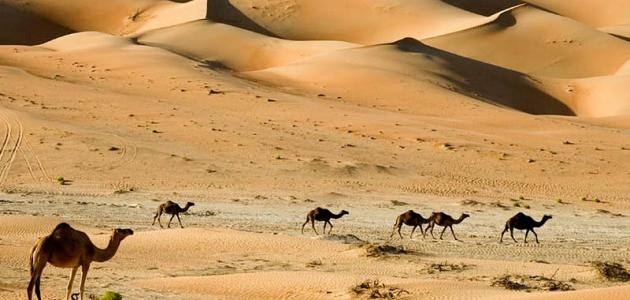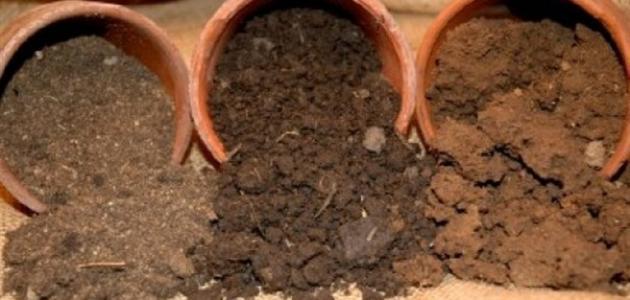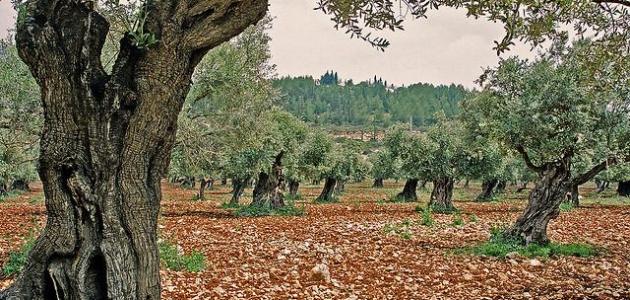desert environment
Desert environments cover more than one-fifth of the land area on the surface of the earth, and they form part of the area of every continent. The Sahara desert located in Africa is the largest desert on earth, which extends over more than ten African countries, while the lowest percentage of these deserts are those that are located in the basin and chains of Utah and Nevada, and in parts of Western Asia, and are known as the cold desert, and among the most important examples It contains the Great Basin Desert, which is the largest desert in the United States of America, and the precipitation is in the form of snow.
The desert is known as one of the dry lands, as the rate of rainfall ranges between zero in some areas of the coastal deserts in South America and the Libyan deserts, and 600 mm in the deserts of Madagascar, and although the rainfall does not exceed 400 mm in most known desert areas, That the authorities consider that the upper limit of annual precipitation in real deserts is less than 250 mm, while those in which annual precipitation ranges between 250-400 mm are called semi-desert regions.
Although desert environments are distinguished by being diverse and changing environments, they all share a lack of moisture needed by plants, due to the vast difference between precipitation rates and evaporation rates in desert lands, and this difference results from the great variation in precipitation times and low humidity. In the atmosphere, high temperatures during the daytime, and the constant blowing of winds, so these areas are considered unsuitable for cultivation, and do not contribute to providing food for humanity, except by providing pastures for livestock.
Read also:definition of natureAs for biodiversity in desert environments, these environments include a large number of special plants, and desert soil is characterized by being rich in nutrients with little or no organic matter, in addition to a large number of vertebrate and invertebrate animals. Mammals are the dominant category in the desert, and there may be some types of small mammals such as kangaroo mice (in English: Kangaroo Mice) in the deserts of North America, but they do not include large numbers of mammals; This is due to its inability to store a sufficient amount of water and the presence of high temperatures, as the desert is unable to provide shelter for animals that protect them from the heat of the sun.
Types of desert environment
The environmental habitat, biome, habitat, or biome of desert environments is classified based on many characteristics into four main types: hot, dry, semi-arid, coastal, and cold regions. Here are some details for each environment:
Hot dry desert environment
Hot, dry desert environments are located near the equator, specifically in North America, Central America, South America, Africa, South Asia, and Australia. There is little rain on the lands of hot, dry environments, but it quickly evaporates, and among the most important deserts that fall within this list are the Sonoran Desert, the Mojave Desert, the Great Desert, and the Kalahari Desert (in English: Kalahari Desert).
Read also:Where is extracted amber stonePlants in hot, dry desert environments are characterized by their ability to live during long periods of drought, and during very hot days and very cold nights, and plants that grow near the surface of the earth often thrive in these environments, such as: cactus (in English: Prickly Pears), and turpentine (in English: Turpentine Bush), and the yucca plant (in English: Yuccas). As for the animals, they adapt by living underground in search of cooler areas, and a few of them only avoid the heat of the day to come out at night from their hiding place. This category is called nocturnal animals or animals with nocturnal activity ( In English: Nocturnal), and there are some few species of mammals in these environments, such as the Kangaroo Rat (in English: Kangaroo Rat), in addition to lizards, snakes, and some types of insects.
Semi-arid desert environment
Semi-arid environments are defined as environments similar to hot, dry desert environments to a large extent, as they have long and dry summers, and small amounts of winter rain fall in them, but the day and night temperatures do not reach the temperature rates reached by hot, dry environments, and it can be said that These habitats are similar to chaparral forests and grassy areas, and semi-arid environments are often not defined as a separate category from other desert environments, and are usually combined with other types on maps.
Plants adapt in these environments through thorns or hairs that grow on them, covering the surface of the plant, and reducing the plant’s loss of water. The leaves of these plants are characterized by being shiny, which gives them the ability to reflect the rays of the sun falling on them. Among the plants that grow in such environments: damsis Or ragweed, pigs’ herb, or ambrosia (in English: Bursage), the plant of tallow (in English: Creosote), the plant of mesquite or the goat’s sheep (in English: Mesquite), as for animals, some types of rabbits, kangaroo rats, and snakes abound in these environments. and lizards.
Read also:Information about fungicoastal desert environment
Coastal desert environments include areas where the weather ranges from warm to moderately cold. These areas are characterized by a cold winter followed by a long, warm, moderate summer. Summer temperatures range between 13°-24°C, while they drop to 5°C or less in The winter season, so that the maximum temperature in the summer is about 35 ° C, and in the winter it is -4 ° C. As for the rates of precipitation in these areas, they range between 8-13 cm annually, and the maximum annual precipitation obtained by these areas reached 37 cm, while the lowest value was 5 cm.
The soil of the coastal desert is characterized by having fine grains with moderate amounts of salts, which makes it somewhat porous and has good water drainage. Some plants in coastal environments showed many adaptation patterns, as they developed their roots so that they remain close to the upper soil surface to ensure their access to water. As for its leaves and stems, they are distinguished by their thick surfaces, which enable them to absorb large amounts of water if it is available and store it for later use. In some plants, the surfaces are corrugated in the form of a series of peaks and longitudinal grooves, so that the stem swells when water reaches it, so that the grooves become less deep and the peaks are spaced. Examples of plants that live in coastal desert environments are the salt bush and black sage, one of the genus of sage or sage, and the plant Chrysothamnus and Little Leaf Horsebrush, which are one of the species of plants in the family Asteraceae, and some plants belonging to the Poaceae family, such as Rice Grass.
Coastal desert environments include a greater number of animals than those in hot, dry and semi-arid environments. Because the climatic conditions here are not that harsh, mammals and some amphibians, birds, and reptiles are animals that have adapted and been able to develop their response to the conditions of coastal desert environments. In his hiding place for a period ranging between 8-9 months until the onset of heavy rains, while amphibians accelerate their life cycle during the caterpillar stage so that they can reach maturity before the weather becomes bad, while insects lay eggs that are in hibernation and remain so until the weather becomes suitable.
cold desert environment
Cold desert environments are distributed in the Antarctic region, Greenland, and the new Arctic region (in English: Nearctic realm). With its short duration, humidity, and moderate warmth, in addition to some precipitation, the winter temperatures range between -2°-4°C, while in the summer they range between 21°-26°C. As for the rains, their annual precipitation rates range between 15 -26 cm, with its highest limit reaching about 46 cm, and its lowest limit reaching 9 cm. The soils of these environments are characterized by being dense, clayey, and saline, with relatively good porosity and good water drainage.
Cold desert environments are characterized by the spread of vegetation in a scattered manner, as plants cover 10% of the shady areas in these deserts, and sometimes this percentage reaches 85%, and deciduous trees are the dominant plants in them, and they adapt to cold environments by Its leaves are thorny, and shrubs or low trees (in English: Scrubs) are the most common plants in it, and the height of plants in this environment ranges between 15-122 cm.
Animals adapt in cold desert environments by digging burrows under the ground to protect themselves from the cold, and among the animals that can live in these environments are: badgers, foxes, many types of mice, and hares or grouse. Jack Rabbits), and Antelope Ground Squirrels, a species of squirrel.
desert environment characteristics
Desert environments differ from each other depending on their location on the surface of the globe and the climate pattern that characterizes them, but they all share together with the arrival of temperatures in them to high rates, although some of them may be characterized by a very cold climate such as the desert of Antarctica, but the desert does not Its definition is derived from temperatures, but from annual precipitation rates, and some desert environments may receive greater amounts of rain than others, but all of them have precipitation rates less than 25 cm per year, and they also lose rain water quickly as a result of the high evaporation rates there. As for the soil in deserts, it is known as dry soil or desert soil (in English: Aridisols), which is arid soil that tends to be rocky or sandy with little organic matter resulting from dead plants; This is due to the lack of vegetation and rain there, and the sharp fluctuations in daily temperatures.
The main features of the ecological habitat of desert environments can be summarized in many points, namely:
- Average annual precipitation is low.
- Large changes in temperature during the day.
- High evaporation rates.
- The soil is coarse-grained.
- The plants are drought tolerant.
The importance of the desert environment
The desert environment has a number of benefits, the most important of which are:
- Mineral wealth: The dry condition of desert environments helps to form and increase the concentration of many important minerals, such as gypsum, borates, nitrates, potassium, and other salts, which accumulate in the desert as a result of the high evaporation rates to be left behind by the water there, and the scarce vegetation cover facilitates the extraction of minerals from the desert land Like bauxite, gold, diamonds, and oil extraction operations, the desert includes about 75% of the known oil reserves in the world.
- Archaeological discoveries: The arid conditions of the desert help preserve ancient human traces, artifacts, and archaeological remains, which helps archaeologists to reach an accurate and sound understanding of how human societies formed to this day. Many mummified bodies of humans from ancient civilizations were found in many desert environments all over the world. From Peru, China, and Egypt.
- Good carbon sinks: Numerous scientific studies have proven that the bacteria found in the sands of the Kalahari desert collect carbon dioxide from the surrounding air and store it in the desert lands, which means that the desert plays an important role in protecting the earth from global warming by absorbing one of the biggest causes of this phenomenon - gas dioxide. Carbon - and prevent it from being emitted into the atmosphere.
Human impact on the desert environment
Man is associated with the desert environment in several ways, as the desert environments for man are a place for leisure, tourism and recreation, as they are associated in people’s minds with the need for calm and isolation from the noise and hustle of the city, enjoying the wonderful rock formations, and the sands of wonderful colors that abound in the desert, as well as man can exercise there Many enjoyable activities such as mountaineering, riding dirt bikes, joining groups of touring or mountain walking, and in addition to entertainment, people interact with desert environments in different forms. People may resort to these environments for economic purposes, such as mining, grazing, road construction, and public utilities. And people here must pay attention to the sensitivity of desert environments, so appropriate management plans must be put in place to preserve wildlife and habitats.
Some human activities may damage the desert environment through unfair practices such as overgrazing, which causes one of the biggest desert problems today, which is desertification, in which a number of environmental habitats are transformed into desert environments, and urban expansion at the expense of these lands exacerbates the problem and makes it difficult to find Appropriate solutions, as desert environments suffer today from the phenomenon of climate change, which makes them hotter and drier environments, and the desert vegetation cover also suffers as a result of these human activities, off-road vehicles, oil production operations, urbanization, and urbanization destroyed desert plant life Which takes a long time to grow again, such as the saguaro cactus or the saguaro cactus, which needs a full 200 years to grow to reach its normal size.
In order to preserve and sustain desert environments, a number of effective solutions must be put in place, such as planting shrubs and herbs in them. To prevent sand from blowing it, in addition to digging trenches necessary to collect rainwater and grains carried by the wind, and to encourage people to take specific roads in the desert with their vehicles, and to encourage residents who live in resorts located in desert cities to replace native desert plants that do not Their care requires large amounts of water with hydrophilic lawns.









